Video
New Body, New Motion by Jessica McKnight
In June of 2010, my mother, Anna-Maria Fiocco, was diagnosed with a common heart malfunction. In July of that same year, she went in for surgery to replace her heart’s mitral valve. 15 minutes after the doctors announced the surgery’s success, my mother went into a sudden cardiac arrest. Eight months later, at the age of 62, she was officially diagnosed as paraplegic after the realization that her legs were permanently paralyzed. She had to re-define what it meant to move, to travel and to live. The re-arrangement of the home and the re-construction of the space were inevitable due to traditional construction. The smallest things, like the height of the sink in inches kept her from the ability of doing her morning ritual. Most architecture isn’t designed and calculated for a body in a wheelchair, or for any other type of body than a “normal” one. Spaces are generally created for a person who is able to stand and walk. This isn’t to say that disability is ignored completely, but it is clear that “seeing disability as a stigmatized social identity and a reading of the body remains largely untaken” (Samuels). In this project, I am going to address the idea of invisible disability in the construction of social and physical space with the topics of social exclusion and architectural normalities in a need of change.
#Vimeo#documentary#concordia#disability#environment#student#communications#communicationstudies#critical disability
0 notes
Photo


BODY, SPACE AND THE BALLET STUDIO by Cathleen Evans
A dance studio is, in theory, a blank slate: an almost empty room, save for a mirror and a bar, which the dancer inhabits and shapes through their physical expression. Studio A, the rental dance space in the Plateau which I chose to explore for my final project, encompasses this ideal. While I visited the studio on three occasions, it felt familiar from the moment I stepped foot on its shiny hardwood surface – a room recognizable to all who have donned a pair of pointe shoes. A part of the larger Studio Bizz dance complex located on the corner of Pontiac and Mont-Royal, the space is comfortingly characteristic: four walls (one adorned with a full length mirror), two windows, a set of free-standing bars, and the lingering smell of stale sweat. Sleek, serene, and somewhat sterile, Studio A appears devoid of any distinguishing attributes – with only a letter to differentiate it from its neighbouring stalls. Created for the sole purpose of offering affordable dance space by the hour, the intentional un-remarkability of the room is written into the ethos of Studio Bizz: a business whose aim is to provide as neutral a space as possible to the potential patron. In sum, Studio A represents the prototype dance studio – a “blank slate” which is unbiased in theory, yet deeply differential in practice.
A variety of factors – not simply ample space and unassuming décor – dictate who may comfortably inhabit the space of a dance studio and how. Gender, race, ability, and class create intersectional barriers so overwhelming only the most specific of bodies are entirely welcome within the studio walls. In no genre are these rigid cultural and physical criteria more pronounced than in classical ballet, a style whose rules, expectations, and traditions are imprinted upon its dancers from their first pirouette to their final bow. In essence, the ballet space presents a phenomenological mold; its inhabitants are forced to either embody its unattainable bar or find a way to work, and dance, around it.
Using the practice of photo-weaving to blur the lines between myself (the dancer) and the studio space, my project aims to present the relationship between the dancer and their studio as one of symbiosis: an embodied pas de deux rather than strict spatial practice.
0 notes
Photo
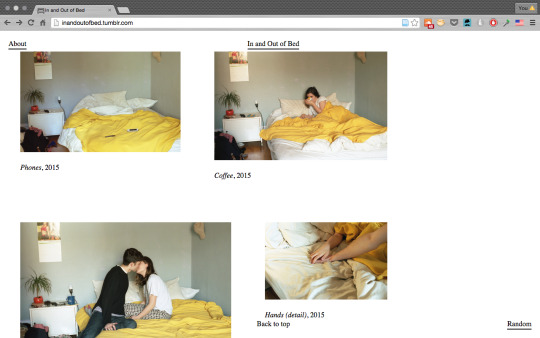
IN AND OUT OF BED By Garrett Lockhart and Danica Pinteric
http://inandoutofbed.tumblr.com/
The exploration of the bed as a socially produced space prompts many questions about the subjectivity of lived experience, dependency, and, representations within a space. How do we experience beds differently? Who is granted access to certain beds? What emotions do certain beds conjure? In and Out of Bed is a standalone collection of photographs that we produce as a response to these questions from our own embodied experiences in the bed that we share. In and Out of Bed is a standalone collection that we envision being exhibited in a physical or online art gallery.
We approached this project with both a primary and secondary methodology. We wanted to capture our experience of the bed from two predominant theoretical frameworks: communicating personal embodied experiences (inspired by Maurice Merleau-Ponty and Jason Farman), and exploring how we produce spaces through patterns of social activity (inspired by Henri Lefebvre).
0 notes
Photo

Mont-Royal Avenue by Anne-Mette Hansen
http://annemette91.tumblr.com/
I decided to do a creative project about the area of the Plateau-Mont Royal with a specific focus on Mont-Royal Avenue. The project is focusing on the history of the space and how it has developed from a working class borough to the multicultural neighborhood that it is today. The project is showing a photo series of old pictures of the avenue from the beginning of the 20thcentury. To re-create the experience of the space I went to the same exact locations and took new pictures of the spaces. The project aims to illustrate and describe how the street has changed.
0 notes
Text
CEMETERY AS AN ARCHIVE OF HUMAN IDENTITY
Essay by Danika and Anna
The practices online in relation to death and the archiving of a deceased person’s digital identity is mirrored in the practices that date before the invention of the internet and before the conception of the term cyberspace coined by fiction writer William Gibson in 1982 (Badulescu, 2011). In light of this fact, we conclude that it is not reasonable to see the two spaces as separate; cemeteries and cyberspace not only both represent heterotopias but also lead to near identical behaviour in relation to the mourning of the dead. More importantly than that, the point that we have insisted on is that they both serve as archives that have recorded lived experiences in varying ways, but that both wind up containing an immense amount of data the deceased. The tombstone, size of plot, location and items left by visitors are similar to the online presence that an identify possesses. If an identity is being lived out through one or several accounts after the passing away of an individual, then the amount of friends, posts to wall and the creation of a memorial page is the equivalent of all that is found on a tomb. The main difference between the online space and the cemetery is the physical versus digital aspect; meaning that the physical may reveal less at first sight than the digital. In addition to this, digital conservation of identity and data after death has come makes it so that the archives are more widely accessible and can be accessed an infinite amount of times. This is a phenomenon that is not witnessed in a cemetery which has closing hours, regulations and private plots and tombs. An issue that is brought up in relation to the creation and preservation of online identity is the authenticity of the information that the individual chose to reveal: what is the real self, what is more authentic? The marks on the body, the embodied, neurological, biological experience; or the online accounts, the selected photos and tidbits, the mini autobiographies, reposts, etc.? This is near impossible to answer, almost as hard as it is to say what happens after death – all that we can be sure of is that it all definitely relates to the individuals identity, seeing as what they choose to post or not says a lot about them same as our actions and words in the physical world say a lot about us.
0 notes
Photo
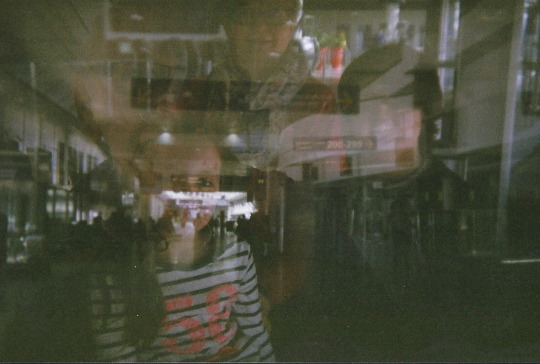
Aéroportraits by Béatrice Viens Côté
as seen on http://aeroportraits.tumblr.com
The project Aéroportraits (translated as “Airportraits” in English) aims to explore Montreal-Trudeau Airport through its various components, such as its design and its people. Indeed, airports are not simply a dot on a geographical map; they are also well thought constructions that come alive thanks to humans. In order to justify the valuable humans’ presence in that space, I decided to lead a discussion with strangers and collect a myriad of airport stories. The conversations were triggered by asking them to tell me about a moment they either experienced or witnessed at the airport and that they would never forget. Thanks to the photographic technique of double exposure, I completed the stories by combining portraits of interviewees with the various surrounding décors. The idea was to create confusion between body and space, two fundamental terms of the course. Moreover, some contradictions seem necessary to airports’ performance. As architect and engineer Daniel Estevez writes, “The airport is often shown as a milieu in tension. […] It is closed but opened, public but private, delimited but proliferating, in operation but under construction, coercive but fun” (23); such contradictions thus constituted the basis to my project. The hoped-for and final objectives were to perceive airports with a more human perspective, or more specifically, as thirdspaces, and to expose how dualism is intrinsic to that space, by, in the meantime, exploring notions of surveillance.
0 notes
Text
THE COMMUTER TRAIN AS A DISCIPLINARY APPARATUS: BODIES AND ORDER -- Essay By Sarah Bibeau and Ana-Patricia Bourgeois
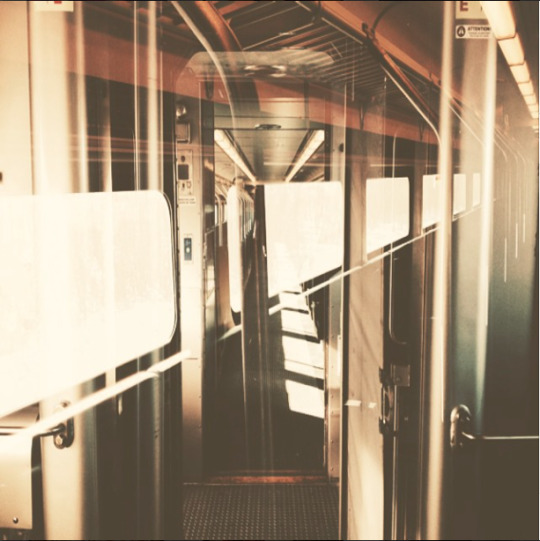
Abstract Shot of the AMT train cabins Photo: Ana Patricia Bourgeois
In “Discipline and Punish” (1975), Foucault focuses on the regulation of bodies and the question of power within particular institutions, using Bentham’s idea of the panopticon. Drawing upon Foucault’s interpretation of technologies of power, as well as Merleau-Ponty’s phenomenological understanding of the environment, and Lefebvre’s idea from which politics and ideologies are embedded within spaces, this research project will focus on the commuter train as a disciplinary device, therefore adding an additional layer to Foucault’s argument. We believe that commuter trains tend to reinforce existing discourses around the orientation of our bodies within this particular space, therefore acting as a disciplinary device similar to the panopticon. We hope to arrive at a better understanding of this space by unpacking the different ways it forces us to behave, as well as the ways discipline is displayed. We believe that this research paper will fit within the greater discourse of this class about how our bodies relate to particular spaces and also about what kind of ideologies are at stake within such spaces. The commuter train doesn’t only help us to go from point A to point B; it is tightly related with old ideologies and follows important paradigmatic assumptions that have been perpetuated throughout the years about acceptable ways to behave within a public space.
0 notes
Photo

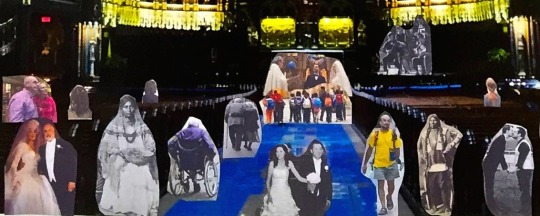

BODIES IN SPACE: The Notre-Dame Basilica of Montreal by Ashley Plescia & Mirelle Lupovici
The Notre-Dame Basilica of Montreal is one of Montreal’s most notable and touristic viewed buildings within the city. By the means of research and experiencing the space first hand, we attempted to re-create The Notre-Dame Basilica of Montreal as a more welcoming space in which all bodies can be welcomed to equally. When analyzing the space, it becomes evident that the historical, social, political, and cultural contexts play a vital role in the lack of bodies that may chose to enter the space.
We were inspired to recreate both the exterior and interior of the church to be able to display it as a space that welcomes all bodies at the same time. We aimed to recreate this space by making a collage, using found images of different bodies and placing them onto larger images of the outside and inside of the church. Our creative component is best suited to demonstrate our argument because it displays a clear indication that we aimed to both challenge the reality of what the space represents and it shows the process of its transformation to represent a space where all bodies can be welcomed too.
0 notes
Link
Doriwatch by Dori Julian and Nick Frai
Just as the most popular original cam girls’ websites (JenniCam, AnaCam, etc.) in the early ages of the Internet, DoriWatch, a channel featuring a series of live broadcasts, allows viewers access into the private space of one of the project’s creators, Dori Julian’s, bedroom on a daily basis. Viewers are able to watch and contact her in real-time through an online chat function, or by email.
The project aims to compare the differences between the public’s interests in making private space and bodies’ public on the web, during the rise of cam girls in the 1990’s, as opposed to now.The project also aims to understand the phenomenon of representing private space online through both a viewer’s and a broadcaster’s perspective.
Through this experimental social, media-based project, we have developed an informed standpoint on the “realness” and gradual banality of these unedited broadcasts. The project explores issues of interest such as authenticity, the relationship between surveillance and self-surveillance, technology’s involvement in making such private content publicly available, etc.
0 notes
Photo
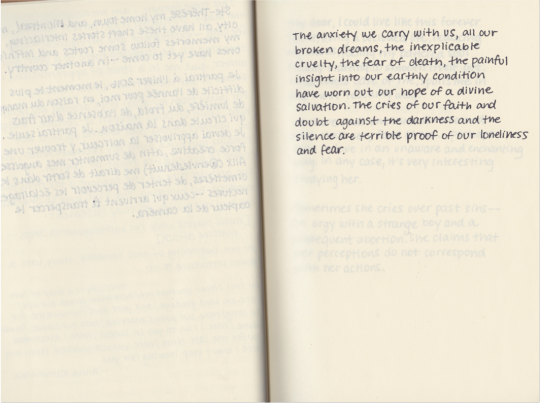

Nocturnal Silences by Noémie Boisclair
First and foremost, this project is a tribute to transmission; a way to speak up about internalized voices gathered through readings and films, then projected onto a space: here Sweden, precisely the city of Malmö. Hélène Cixous explains the importance of women writing in Laugh of the Medusa. She says: “I shall speak about women’s writing: about what it will do. Woman must write her self: must write about women and bring women to writing, from which they have been away as violently from their bodies—for the same reasons, by the same law, with the same fatal goal.” (347) Even though a lot of the words written in my journal are from different writers, I do reflect on them. The act of writing becomes a way to perpetuate women’s voice and develop a language that represents taking possession of your own body and your own memories. To silence oneself is to tame intuition, as Terry Tempest Williams says, and “when one woman doesn’t speak, other women get hurt.” (122) If the ability to speak up has been violently taken away from women, they need to re-appropriate their bodies in order to influence each other.
0 notes
Photo

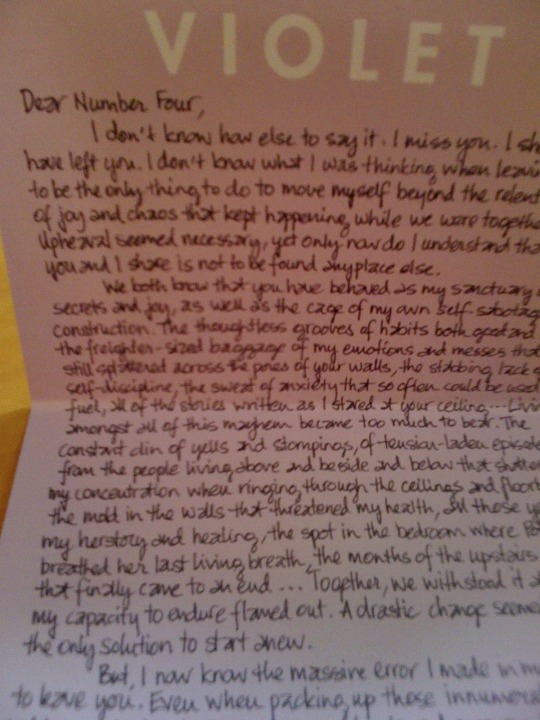

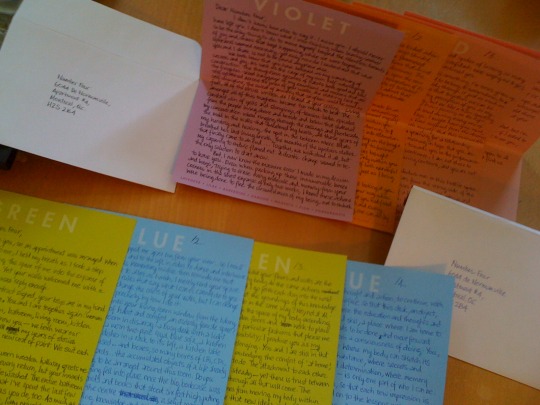
The Reconciliation by Lorrie Edmonds
In writing two letters of love and longing to my apartment – that I lived in for nine years, left for six months, and have since returned to – I have chosen to examine my own relationship to the space and place of “home”.
0 notes
Text
10TH ANNIVERSARY OF PAMELA GEORGE’S PASSING: AN HOMAGE by Frederique Rajotte

According to the RCMP, 1 200 Canadian Aboriginal women have gone missing and have been murdered between 1980 and 2012. Emmanuelle Walter describes it in her book Soeurs Volées as “a true feminicide, behind the spotless and peaceful image of these large territories is hidden an astonishing reality” This book by Emmanuelle Walter deepened my knowledge on this ongoing reality and helped me create this picture montage to further the discussion on this feminicide. The missing and murdered aboriginal women in Canada, a theme that we have looked at in class, has resonated with me since the reading of Sherene Razack’s chapter on the murder of Pamela George. I believe that this project holds a strong purpose as it tries to pay homage to Pamela George and all the 1 200 missing and murdered Indigenous women. I have blended the theories from Sherene Razack, Gira Grant and Sara Ahmed to give a deeper meaning to my project. This project is politically charged as it tries to recreate a specific type of body, the one of Pamela George on a side street, which is trying to re-create the lived space. The picture montage tries to expose the ways in which Indigenous women are represented in the media, as socially fragile and vulnerable. I believe that through this representation one will be able to feel the danger that aboriginal women face in such spaces.
0 notes
Photo
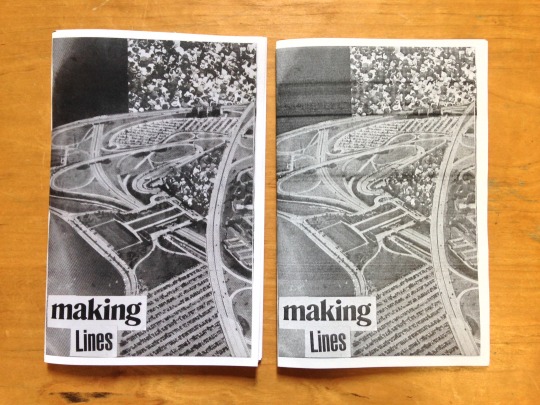
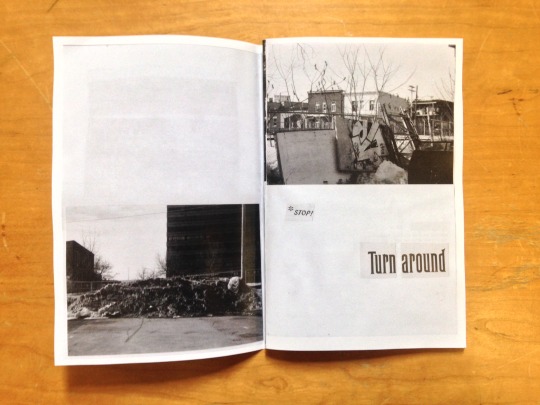

MAKING LINES: A ZINE ABOUT BLOCKAGE, FLOW AND DIVISION OF SPACE by Maddy Fenton
Photos taken by author at Laos and Henri Julien. This is near the area of railway tracks she explored for this project.
0 notes
Photo
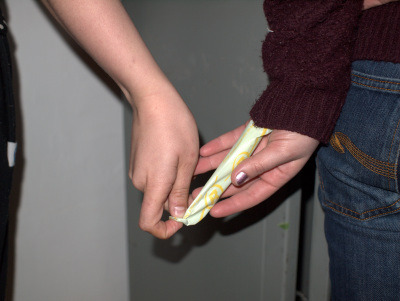
Menstrual Memories Zine by Gabrielle Allain and Evan Smith
0 notes
Photo

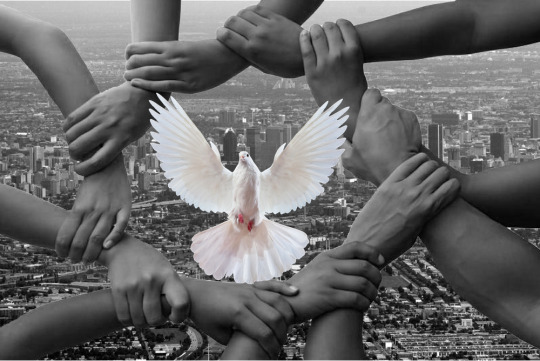

A PARADOXICAL REFUGE: REPRESENTATIONS OF THE SOCIALLY CONSTRUCTED UNITED CHURCH by Lisa Suliteanu
0 notes
Audio
Radio by Rory Warnock
0 notes